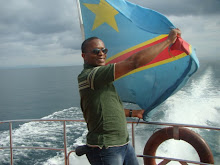
Crossing the Border Gisenyi / Goma Not Always Easy –
John parked the car while Catherine and I were dealing with the administrative part of the border crossing. The line on the Rwandan side was somehow long. The border is busy. People having business to do here and those not having any business being at the border are all roaming around. Since John’s car could not cross the border (against Company policy), we unloaded our luggage and had it wheeled out/carried out by three young men. While walking in the no man’s land, I saw my friend Kizito waiting on the Congolese side of the border. It was so great seeing my old friend after more than 13 years. He was still the same strong and good humored friend I knew during my College years. The whole scene didn’t feel real until I shook Kizito’s hand. I am back home again, in my native
While our passports were being processed, I noticed three ladies standing next to the kids carrying our bags. Their demeanor told me something was up. The one in the middle said that they were intelligence officers and, for security purposes, wanted to check our bags. My brandishing of our invitation letter by the British Embassy did not deter them from insisting to check our bags. When we entered the two-room office we found more people than needed for a security office. I told myself it must have been an improvised check-up room. Zawadi, the most persistent of the trio, checked one of my bags first with bared hands (I had three bags: one of them filled with clothes friends in the
By that time, the room was getting a little way too packed. After checking of the second bag, I told Zawadi that I was a son of the Congo and would not let her treat me like a foreigner and that I would not let her check one more bag. She thought I was kidding. But, she quickly realized that I was damn serious when I got Catherine out of the room and ordered the three kids waiting outside to carry our bags to the “Padjero” SUV Kizito rented for us. At first I thought the three ladies were meticulously checking our bags just to somehow force us to give them money so they could stop the search. But, this practice of checking bags bared handed was not the practice of the Congolese agents only. We experienced it on the Rwandan side a couple of days later while leaving Goma for
The reason of the search, I came to understand, is due to the facts that Rwandans and Congolese in this region look daggers at each other. It’s been proven that, for quite sometimes, the Rwandan government of Paul Kagame has made it its objective to destabilize
We were running late for our meeting with Virginie Mumbere, PR at HEAL
If you’re wondering why HEAL is capitalized it’s because it stands for Health, Education, Action and Leadership. HEAL
Lyn introduced us to Modestine, a counselor with the “Wamama Simameni” program, who gave us a brilliant tour of the hospital. The “Healing Arts” building is a sewing shop where women learn some dressmaking skills. The products of their works are sold in the back of the room. Some very beautiful fabrics, dresses, skirts, bracelets, and more, are sold here. The women were pleased that Catherine bought a couple of articles from them. In my mind I was wondering whether the skills in these women could be used for something else than dressmaking. Women have such great potential for future development of the
There were children everywhere we went. Some of them had smiles on their faces. But, most of them seemed sad. Sad for the violence they might have witnessed. Sad for seeing their parents, especially mothers, in pain. Sad for seeing no light, no way out, in their lives of misery. Sad to see there seems to be no reliable government working to brighten up their future. It’s the accumulation of so much rage that makes most kids an easy pray for the rogue armed groups swarming in this area.
We ended our visit of HEAL
Virginie invited us to see AMAVESA women in action Saturday November 7th.

